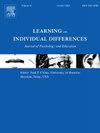How might creative problem-solving be related to prosocial motivation? An exploratory pilot study
IF 3.8
1区 心理学
Q1 PSYCHOLOGY, EDUCATIONAL
引用次数: 0
Abstract
The current exploratory pilot study aimed to investigate the relationship between creative problem-solving (CPS) and prosocial motivation, controlling for the effects of covariates known to be related to prosocial motivation. A total of 125 undergraduate and graduate students participated by responding to the self-report questionnaires measuring prosocial motivation, uncertainty tolerance, perspective-taking, and anticipated repayment for prosocial behavior and then provided a narrative response to a CPS task in which they generated solutions to a social problem about COVID-19. A new dimension of CPS, social utility, was scored to create a composite CPS score along with the conventional CPS measures of fluency and originality. A multiple regression analysis showed that CPS was significantly related to prosocial motivation. The findings are discussed regarding the social asset of CPS, the expanded scope of measuring CPS, and the potential implications of teaching for creativity.
Educational implications
Creativity is known to contribute to cognitive assets such as academic and professional achievement, and creative problem-solving is a well-documented essential learning and workplace skill. The present study contributed to expanding the cognitive asset of creative problem-solving into the social asset. This expansion would encourage educators to see the merit of teaching for creativity in the classroom as well as to advocate for creativity in teaching for everyone. Additionally, we added a social utility dimension to the assessment of creative problem-solving. As such, we propose that the social utility dimension of creative problem-solving serves to guide educators in integrating creative problem-solving in order to increase the social assets of students in their practices.
求助全文
约1分钟内获得全文
求助全文
来源期刊

Learning and Individual Differences
PSYCHOLOGY, EDUCATIONAL-
CiteScore
6.60
自引率
2.80%
发文量
86
期刊介绍:
Learning and Individual Differences is a research journal devoted to publishing articles of individual differences as they relate to learning within an educational context. The Journal focuses on original empirical studies of high theoretical and methodological rigor that that make a substantial scientific contribution. Learning and Individual Differences publishes original research. Manuscripts should be no longer than 7500 words of primary text (not including tables, figures, references).
 求助内容:
求助内容: 应助结果提醒方式:
应助结果提醒方式:


